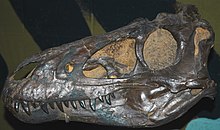Deinodon lancensis
|
Nanotyrannus Temporal range: Late Cretaceous, 68.5–66 Ma |
|
|---|---|
 |
|
| Holotype skull | |
| Scientific classification | |
| Kingdom: | Animalia |
| Phylum: | Chordata |
| Class: | Reptilia |
| Clade: | Dinosauria |
| Order: | Saurischia |
| Suborder: | Theropoda |
| Family: | †Tyrannosauridae |
| Subfamily: | †Tyrannosaurinae |
| Genus: |
†Nanotyrannus Bakker, Currie & Williams, 1988 |
| Type species | |
|
Gorgosaurus lancensis Gilmore, 1946 |
|
| Synonyms | |
|
|
Nanotyrannus ("dwarf tyrant") is a potentially dubious genus of tyrannosaurid dinosaur. It is known only from two specimens (possibly three), which are potentially juvenile specimens of the contemporary genus Tyrannosaurus rex.
Nanotyrannus is based on CMNH 7541, a skull collected in 1942 by David Hosbrook Dunkle and described by Charles W. Gilmore in 1946, who classified it as a new species in the tyrannosaur genus Gorgosaurus as G. lancensis. In 1988, the specimen was re-described by Robert T. Bakker, Phil Currie, and Michael Williams, then the curator of paleontology at the Cleveland Museum of Natural History, where the original specimen was housed and is currently on display. Their initial research indicated that the skull bones were fused, and that it therefore represented an adult specimen. In light of this, Bakker and colleagues assigned the skull to a new genus, named Nanotyrannus for its apparently small adult size. The specimen is estimated to have been around 5.2 metres (17 ft) long when it died. However, a detailed analysis of the specimen by Thomas Carr in 1999 showed that the specimen was in fact a juvenile, leading Carr and many other paleontologists to consider it a juvenile specimen of Tyrannosaurus rex.
In 2001, a more complete juvenile tyrannosaur (nicknamed "Jane", catalogue number BMRP 2002.4.1), belonging to the same species as the original Nanotyrannus specimen, was uncovered. This discovery prompted a conference on tyrannosaurs focused on the issues of Nanotyrannus validity, held at the Burpee Museum of Natural History in 2005. Several paleontologists who had previously published opinions that N. lancensis was a valid species, including Currie and Williams, saw the discovery of "Jane" as a confirmation that Nanotyrannus was in fact a juvenile T. rex. On the other hand, some, such as Peter Larson, continued to support the hypothesis that Nanotyrannus lancensis was a separate but closely related species. In 2015, Professor Phil Manning and Dr Charlotte Brassie of Manchester University studied Jane using a LIDAR scanner, and using data and computer modelling, their reconstruction of body mass suggested that Jane had a 600 kg - 900 kg body mass, far lower than would be expected for a Tyrannosaurus. Also in 2015, Assistant Professor Holly Woodward Ballard of Oklahoma State University used histology to examine a thin slice of Jane's femur. Counting the rings within Jane's bone material showed that Jane was 11 years old, and bone histology suggests that Jane was immature and still growing.
...
Wikipedia
